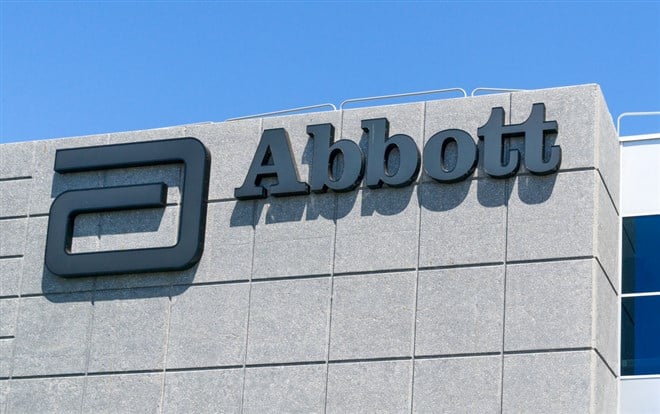 NYSE: ABT) Dividend Stock " width="660" height="414">
NYSE: ABT) Dividend Stock " width="660" height="414">
Abbott Laboratories (NYSE: ABT) may offer you some excellent dividend opportunities because it's in one of the most recession-proof sectors: health care. Abbott Laboratories offers the gamut of lifecycle health and medical products from baby formula to blood glucose readers to general pharmaceuticals and a wide range of treatments for disease. The company also produces COVID-19-related products.
Let's take a look at how to buy Abbott Laboratories, the pros and cons of purchasing and why you may want to reserve a spot for the stock in your portfolio.
About Abbott Laboratories
Abbott Laboratories, headquartered in North Chicago, develops and sells pharmaceutical, diagnostic, nutritional and medical device products worldwide.
The company's products treat a range of diseases, including:
- Pancreatic exocrine insufficiency
- Irritable bowel syndrome or biliary spasm
- Intrahepatic cholestasis
- Depressive symptoms
- Gynecological disorder
- Hormone replacement therapy
- Dyslipidemia
- Hypertension
- Hypothyroidism
- Ménière's disease
- Vestibular vertigo
The company also produces systems such as molecular diagnostics systems and point of care systems, point-of-care testing for HIV, SARS-CoV-2, influenza A and B, RSV and strep A. The company also produces cardiometabolic test systems, consumer self-test systems and automation solutions for use in laboratories. The company also creates products to treat cardiovascular diseases and diabetes.
The history of Abbott Laboratories began in 1888 when Dr. Wallace C. Abbott produced “alkaloidal” medicine granules and in 1916, produced chlorazene, an antiseptic, and butyn in 1922.
The company's initial public offering occurred in 1929 and expansion increased, even during the Great Depression.
In 1964, Abbott acquired M&R Dietetics and its baby formula Similac and in 1972, the company developed the ABA-100 blood chemistry analyzer and Ausria, a breakthrough radioimmunoassay test for detecting hepatitis. This is when Abbott started honing in on diagnostics.
In 1985, Abbott Laboratories created the first HIV test. Later on, in 2002, it created Humira, the first fully-human monoclonal antibody drug.
Following the onset of the global COVID-19 pandemic, Abbott created and sold diagnostic tests for COVID-19.
Abbott has weathered the pinball-like market this year, mostly due to its diversified business. The company had $11.3 billion in worldwide sales, $1.43 in adjusted diluted EPS, which reflects 22.2% growth compared to 2021. It had $2.3 billion in global COVID-19 testing-related sales. The company also had more than 25% organic growth (18.7% reported) in sales of its FreeStyle Libre systems.
Why Buy Abbott Laboratories Stock?
Let's take a look at the reasons why you may want to buy Abbott Laboratories.
- Staying power: Its history and diversified opportunities mean that the company will continue to roll out life-altering products and in a safe, highly diversified niche.
- Diagnostics: In all areas of diagnostics, Abbott does well. However, there's no question that companies have made money off the pandemic, and Abbott Laboratories is no exception. In 2021, Abbott made $1.9 billion from its coronavirus diagnostic products, and as the virus doesn't seem to be waning, it'll continue to rake in the revenue.
- Dividend fruit: With a dividend stock track record that has spanned 50 years, Abbott offers a dividend yield of 1.72% and a dividend of $1.88. The dividend payout ratio is 43.62%.
Why may you want to steer clear of Abbott Laboratories, on the other hand?
- Recalls: Abbott recalled certain infant formula products from a plant in the U.S. following cases of bacteria cronobacter sakazakii and salmonella in some infants. Abbott found traces of bacteria in parts of its facility but they didn't match the samples. Abbott was found not to be linked to the salmonella cases and all samples tested negative for bacteria. It may damage Abbott's earnings but many experts believe it shouldn't hurt the company long-term.
- Analyst ratings: Let's compare two companies. Medtronic has a consensus target price of $117.13, indicating a potential upside of 31.27%. Abbott Laboratories has a consensus target price of $135.75, which means a potential upside of 25.43%. Medtronic's higher possible upside indicates Medtronic's favorability over Abbott Laboratories.
Learn more: Should You Buy Dividend Stocks During Inflation?
How to Buy Abbott Laboratories Stock
Think Abbott Laboratories' storied history means it deserves a spot in your portfolio? Let's take a look at how to buy shares of Abbott Laboratories, step by step.
Step 1: Choose a brokerage.
If you don't already have a brokerage account, you'll have to shop around. Take a look at fees, account minimums, platform options and other perks. If you prefer to trade shares or want to take a buy-and-hold approach like many dividend investors? Your choice of brokerage should reflect those choices.
Step 2: Decide how many shares you want to purchase.
How much money do you want to sink into your investment? As of this writing, the stock was $109.72. If you have $1,000 to invest, you could buy nine shares of the stock. If your brokerage allows you to buy fractional shares, you could buy just over nine shares.
You can always buy more shares on a regular basis through an automated investing plan. For example, you may ask your broker to purchase new shares of the company every month.
Step 3: Choose your order type.
Your trading platform will give you several order types to choose from and should depend on your trading goals. The order type helps you determine when your broker should trade your shares:
- Market order: A market order means your trade will occur at the available market price without a specified price limit.
- Limit order: A limit order lets you specify the price at which you want to buy or sell for more control over the price.
- Stop order: A stop order allows you to buy or sell a stock when the stock price moves over or below a specific price, called the stop price.
- Stop-limit order: A stop-limit order combines features of a stop and limit order to execute of a specified price or better after a stop price is reached. After this, the stop-limit order becomes a limit order to buy or sell at the limit price or better.
- Stop-loss order: A stop-loss order can limit losses and allows you to sell your asset when the price drops to or below a pre-specified level.
Most buy-and-hold investors go for a market order because you don't need to worry about getting the absolute best price because it's likely that you'll be holding the stock for years.
Step 4: Execute your trade.
You're ready to purchase. Double-check that you've entered the correct ticker symbol: ABT and check the number of shares you would like to purchase.
Choose Abbott Laboratories Based on Your Goals
If you think Abbott Laboratories will fit into your goals (short-, mid- and long-term goals) you may want to consider this "steady-as-she-goes" stock.
There is a lot of research that goes into identifying your goals, so learn more about dividends at DividendStocks.com.
Learn more: How to Invest and Pick Dividend Stocks for Passive Income





